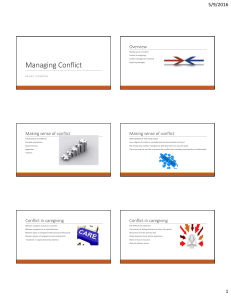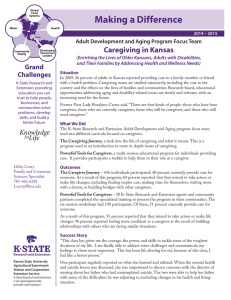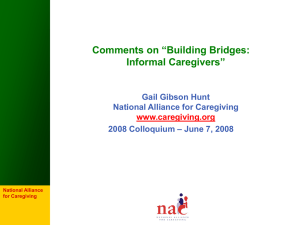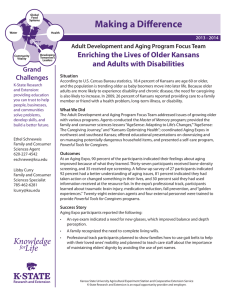“I am now separated, which has hurt my kids; in return
advertisement
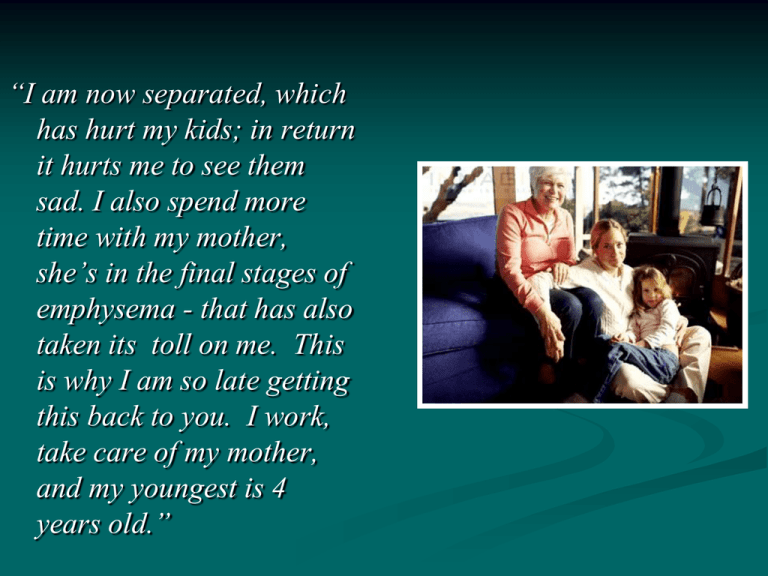
“I am now separated, which has hurt my kids; in return it hurts me to see them sad. I also spend more time with my mother, she’s in the final stages of emphysema - that has also taken its toll on me. This is why I am so late getting this back to you. I work, take care of my mother, and my youngest is 4 years old.” WHY do family caregivers provide care? WHAT are the rewards, benefits, opportunities of caregiving? Opportunities/Benefits of Caregiving Very few studies on the positive aspects of caregiving Benefits or “gain” = any positive affective or practical return experienced as a result of becoming a caregiver (Kramer, 1997) Reasons identified in the limited existing literature (e.g., Bowers et al., 2001; Brody, 1981; Pinquart & Soerensen, 2003) comprise four domains: Altruism, Exchange, Need, Affection Examples of Benefits Altruistic motives “It’s the right thing to do” “It’s consistent with my moral/ethical principles” “I feel responsible” (“I help because of my religious beliefs”) Exchange motives “I gain knowledge I can use later” “I gain skills I can use elsewhere” (“The elder also provides some help to me”) (“I will eventually benefit financially”) (“We share living expenses”) (“I receive some monetary compensation”) Need “There’s nobody else who can do it” “The elder won’t ask for or accept help from anyone else” Affective Reasons “I appreciate being close to the elder” “It makes me feel good about myself” “It enables me to appreciate life more” “It makes me feel useful/needed” “I want to give something back to this person” In sum, many caregivers find that there are both stresses and rewards associated with caregiving A Few Selected Findings from our national study funded by the Alfred P. Sloan Foundation Neal, M. B., & Hammer, L. B. (2007). Working couples caring for children and aging parents: Effects on Work and Well-Being. Mahwah, NJ: Lawrence Erlbaum Associates, Inc. An Example: Outcomes and Effective Coping Strategies As revealed in a national study funded by the Alfred P. Sloan Foundation: Neal, M. B., & Hammer, L. B. (2007). Working couples caring for children and aging parents: Effects on work and well-being. Mahwah, NJ: Lawrence Erlbaum. Key Findings: Outcomes For both wives and husbands: • Work interfered with family to a greater extent than family interfered with work • Higher levels of clinical depression than the general population • Higher levels of positive work-family spillover than workfamily conflict Wives had higher levels of absence from work than husbands each month due to family care Wives had higher levels of depression than husbands Key Findings: Benefits Caregivers also received help from their aging parent(s) (e.g., financial, emotional, child care, household assistance) Receiving help from aging parents was associated with: greater relationship quality with the aging parent greater self-ratings of performance as a caregiver (Ingersoll-Dayton, Neal, & Hammer, 2001) Positive spillover: was related to lower depression “crossed over” leading to decrease in spouse’s depression over the year (Hammer, Cullen et al., 2005) Key Findings: Relative Effects of Role Characteristics Subjective role characteristics (spousal, child care, parent care, and job role quality) more important than objective characteristics (e.g., # cared for, # hours) in predicting outcomes Spousal role quality (rewards outweighed stressors) was especially important Objective characteristics did predict some outcomes Working more hours resulted in : Increased work-to-family conflict for both Poorer work performance for men Key Findings: Coping Strategies 3 primary types of strategies were used: Increasing emotional resources - e.g., getting moral support and comfort from others, trying to find humor in the situation Increasing prioritizing - e.g., protecting or setting aside time for important activities, not losing track of what’s important Decreasing social involvement – e.g., limiting social activities, spending less time with spouse/partner, spending less time with other family members What Worked and What Didn’t Positive outcomes were associated with increasing emotional resources increasing prioritizing Negative outcomes were associated with decreasing social involvement Men and women used different strategies: More wives than husbands decreased social involvement More husbands than wives increased prioritizing The benefits of increasing emotional resources “crossed over” and extended to the spouse The use of coping strategies had greater effects on work-family fit and well-being than on work outcomes What Caregivers Can Do… Working Caregivers Can: Use effective coping strategies Increase emotional resources Take care of self and marital relationship Seek emotional support from family, friends, coworkers, supervisors, maybe a formal support group for caregivers A sense of humor and spiritual beliefs may ease stress Increase cognitive resources Create a schedule and set priorities Be prepared for unexpected events, emergencies Plan time for own needs too Prioritize tasks – stop certain activities, reduce expectations to be in line Working caregivers can… (cont.) AVOID social withdrawal – DO maintain social relationships with friends DO take care of their marital relationship Ask for/get help with caregiving tasks from family members, others Use available supports at work and in the community Make use of available technology (e.g., cell phones, internet) Make Use of Aging/Family Services Get help with: Finding services/supports for the aging parent Developing practical caregiving skills Finding ways to enhance the quality of relationships with one’s spouse, children, elders Identifying ways aging parents may help or reciprocate Request information re: caregiving resources for employers Advocate for Change The U.S. government lags far behind other countries in providing public support for family care, including paid family leave - Caregivers may wish to advocate for paid family leave - Policy makers can identify ways to make this feasible What Employers/Managers Can Do Improve organizational work-family culture (family friendliness): Offer workplace supports (policies, benefits, services) Train managers to be sensitive of employee’s work-family issues Minimize long work hours for employees Increase flexibility (work schedule and place of work) Advertise/support use of available workplace supports A Few Resources The Family Caregiver Alliance at www.caregiver.org - state-tostate information for caregivers, caregiving advice, fact sheets www.aarp.org/families/caregiving/ - AARP website for caregivers www.networkofcare.org - options for Oregon and California 1-800-677-1116 - Elder Care Information – will help locate the Area Agency on Aging where the elder lives www.ncoa.org - National Council on Aging www.Elderweb.com Resources (cont.) Books by Wendy Lustbader, M.S.W. Taking Care Of Aging Family Members (practical ideas to make care easier for both the giver and receiver) Counting On Kindness (discusses what it’s like to receive care – what ill people wish their caregivers knew) Sourcebook for Employers: www.sandwiched.pdx.edu In closing, a final thought: Let us take care of the children, for they have a long way to go. Let us take care of the elders, for they have come a long way. Let us take care of those in between, for they are doing the work. - Traditional African Prayer Questions? Comments? Thank you for your interest! Margaret B. Neal, Ph.D. Director, Institute on Aging, Portland State University P.O. Box 751 Portland, OR 97207-0751 nealm@pdx.edu 503.725.5145
